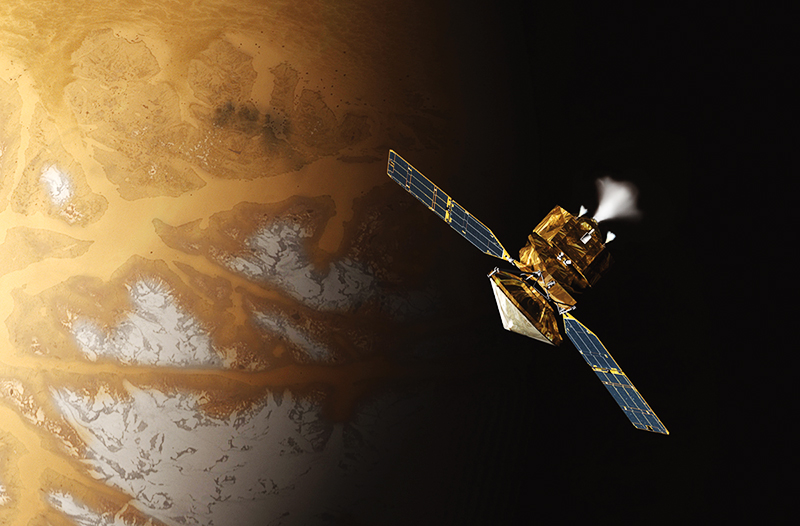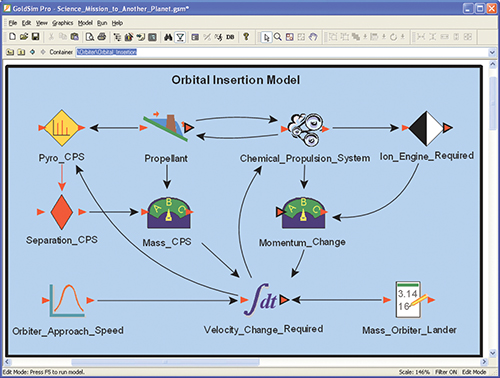
Difficult Decisions Made Easier
Originating Technology/NASA Contribution
NASA missions are extremely complex and prone to sudden, catastrophic failure if equipment falters or if an unforeseen event occurs. For these reasons, NASA trains to expect the unexpected. It tests its equipment and systems in extreme conditions, and it develops risk-analysis tests to foresee any possible problems.
The Space Agency recently worked with an industry partner to develop reliability analysis software capable of modeling complex, highly dynamic systems, taking into account variations in input parameters and the evolution of the system over the course of a mission.
The goal of this research was multifold. It included performance and risk analyses of complex, multiphase missions, like the insertion of the Mars Reconnaissance Orbiter; reliability analyses of systems with redundant and/or repairable components; optimization analyses of system configurations with respect to cost and reliability; and sensitivity analyses to identify optimal areas for uncertainty reduction or performance enhancement.
Partnership
For this work, NASA turned to GoldSim Technology Group LLC, of Issaquah, Washington, a privately held software company that delivers software and services to help people understand complex systems and make better decisions. GoldSim, the company’s namesake simulation software, was originally developed for long-term safety analyses of nuclear waste disposal, and is currently used by the U.S. Department of Energy and the U.S. Nuclear Regulatory Commission, among others. It is the company’s flagship product and is widely used for performance assessment in the nuclear arena, most notably at the Yucca Mountain Project in Nevada, the Nation’s first long-term geologic repository for spent nuclear fuel and high-level radioactive waste.
The company worked with NASA through a Small Business Innovation Research (SBIR) grant with the Jet Propulsion Laboratory to develop and demonstrate a new module for the GoldSim software: an integrated, total-system risk and reliability analysis approach based on dynamic, probabilistic simulation. This new module (the Reliability Module) added features to the software to facilitate simulation of space missions.
Previously, most NASA studies of mission risk and reliability used a methodology known as fault tree analysis, which was often difficult to implement for complex systems that changed over time. Instead of using fault trees, the GoldSim methodology actually simulates the behavior of the mission components over the full duration of the mission, explicitly representing how the various components evolve over time and the probabilities involved. The analysis is intensive and computes the possible ways that the mission may fail, along with their probabilities.
This approach now provides a valuable new systems analysis capability to complement current NASA systems analysis approaches. In particular, it is useful for impact studies, risk/cost/benefit analyses, risk/uncertainty analyses, model integration, and model-based design/model-based engineering.
The development of the new module marked the successful completion of the NASA-funded research project to demonstrate the suitability of the GoldSim software for evaluating the risk and reliability of future NASA missions.
The company released the Reliability Module to the public in September 2005.
Product Outcome
GoldSim is used to create computer models that simulate the performance of complex systems in business, engineering, and science. In general, the purpose of such models is to simulate the future behavior of a system and then determine what can be done to improve its performance. These models are used to gain a diagnostic understanding of the system, ask “what if” questions about it, and evaluate alternative designs, policies, and plans. It is used by organizations worldwide.
The software is highly graphical and extensible, able to quantitatively represent the uncertainty inherent in complex systems, and allows users to create compelling models that are easy to communicate and explain to diverse audiences. Users build a model in an intuitive manner by literally drawing a picture (an influence diagram) of their system. In a sense, GoldSim is like a “visual spreadsheet” that allows users to graphically create and manipulate data and equations. It moves beyond spreadsheets, however, by making it much easier for users to evaluate how systems evolve over time and predict their future behavior.
The primary applications for the software fall into three categories: engineered systems modeling, environmental systems modeling, and business modeling.
For many complex engineered systems (such as space and defense systems, industrial facilities, mines, power plants, and computer networks), it is necessary to predict measures such as the system’s reliability or risk. GoldSim can be used to simulate the reliability and performance of complex engineered systems over time.
The Reliability Module (the result of the NASA SBIR grant) supports the software’s ability to perform engineering systems analysis, as it consists of predicted reliability metrics (e.g., reliability and availability) for the overall system and for individual components within that system. The Reliability Module can also be used to compute the probability of specific consequences (e.g., catastrophic failure of the system) to support risk analysis. GoldSim catalogs and analyzes failure scenarios, which allows for key sources of unreliability and risk to be identified.
GoldSim can also be used to create realistic models of complex, real-world, multimedia environmental systems. Users can explicitly represent the uncertainty inherent in these systems, in order to carry out risk analyses, evaluate potential environmental impacts, and make better resource management decisions. According to the company, GoldSim is, for this purpose, the premier tool in the world for carrying out performance assessments of proposed and existing radioactive waste management sites.
GoldSim is also useful for a wide range of other environmental systems modeling applications, including water balances and water quality management at mines and other constructed facilities; municipal water resources management and planning; the performance of existing or proposed landfills, hazardous waste sites and engineered disposal facilities; environmental impacts associated with various mine development and closure options; the transport and fate of contaminants in aquifers, wetlands, lakes, and other ecosystems; transmission of infectious diseases; and the transport and fate of pharmaceuticals and other compounds within biological systems.
Another arena where GoldSim has found ais in business modeling. Most business modeling today relies on the use of spreadsheets and/or project management software to create project schedules, do simplified risk analysis calculations, carry out cost and revenue projections, and perform other simple financial analyses. Although such tools are useful and applicable in many cases, they generally do not have the ability to represent the complex dynamics and uncertainties present in real-world business systems. As such, the projections produced by these tools often do not provide a realistic representation of the future. This can lead to poor decisions. GoldSim provides users with the ability to transform business modeling into a more quantitative, rational, and defensible analysis.
It provides business planners with the tools to evaluate alternative strategies and policies, and identify those that offer the greatest potential for success; determine the optimal portfolio of projects, resources, and/or investments; develop program plans that provide the highest likelihood of meeting objectives on time and under budget; and evaluate risks, and then identify cost-effective preemptive measures and contingency plans that minimize adverse impacts. Business planners can also use this software to evaluate the performance of supply chains or design and evaluate financial instruments.
All of the engineering systems modeling, environmental systems modeling, and business modeling applications can benefit from the collaborative research performed by NASA and GoldSim. In fact, the company sees this software being beneficial in even more arenas.
“We also think it has a lot of potential in other fields where risk and reliability are important—areas such as defense, automotive, and electronics. It isn’t just a matter of doing risk calculations; it’s important to really understand the sources of risk or unreliability in order to be able to design optimal solutions. That’s what our GoldSim software is all about,” said Ian Miller, president of GoldSim.
GoldSim® is a registered trademark of GoldSim Technology Group LLC.

The GoldSim software aids in uncertainty reduction and performance enhancement by providing decision makers with a highly graphical, multidimensional analysis tool. This screen shot is a seemingly simple depiction showing some of the elements that came into play while planning the complex orbital insertion of the Mars Reconnaissance Orbiter.

Artist’s concept of the Mars Reconnaissance Orbiter (MRO) during the critical process of Mars orbit insertion. GoldSim software helped make this part of the mission a success.













